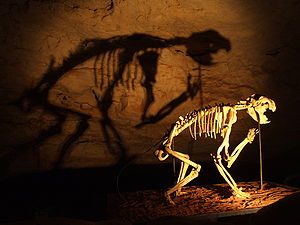Marsupial lions
| Marsupial lions | ||||||||||||
|---|---|---|---|---|---|---|---|---|---|---|---|---|

Skeleton of a marsupial lion |
||||||||||||
| Temporal occurrence | ||||||||||||
| Upper Oligocene to Pleistocene | ||||||||||||
| 25 million years to 50,000 years | ||||||||||||
| Locations | ||||||||||||
| Systematics | ||||||||||||
|
||||||||||||
| Scientific name | ||||||||||||
| Thylacoleonidae | ||||||||||||
| Gill , 1872 | ||||||||||||
The marsupial lions (Thylacoleonidae) are a family of extinct marsupials that lived in Australia until probably around 45,000 years ago . They were the largest predators among the Australian mammals. Some early forms were only as big as domestic cats, later species of the genus Wakaleo were at least comparable in size to a leopard, while the largest and youngest species, Thylacoleo carnifex , varied in size between a female and a male lion. They had a body mass between 110 and 160 kg, possibly even more. Although their body was relatively short, Thylacoleniden were significantly heavier than most of the same length predators because they were significantly more powerfully built.
Features and way of life
The animals are called 'marsupial lions' because of their skull, which is similar in shape to the cat-like predators ; there is no relationship. They are classified in the order Diprotodontia , their closest relatives still living today are the herbivorous wombats and koalas . Like these, they lived primarily in the trees of the forests from which they hunted.
Systematics
A total of four genera of marsupial lions are recognized today.
- Genus † Microleo
- † Microleo attenboroughi (Upper Oligocene )
- Genus † Lekaneleo
- † Lekaneleo roskellyae (Middle Miocene ); formerly belonging to the genus Priscileo
- Subfamily Wakaleoninae
- Genus † Wakaleo
- † Wakaleo alcootaensis (Upper Miocene )
- † Wakaleo oldfieldi (Lower - Upper Miocene )
- † Wakaleo pitikantensis (Upper Oligocene ); formerly belonging to the genus Priscileo
- † Wakaleo vanderleueri (Middle - Upper Miocene )
- Genus † Wakaleo
- Subfamily Thylacoleoninae
- Genus † Thylacoleo
- † Thylacoleo carnifex ( Pleistocene )
- † Thylacoleo crassidentatus ( Pliocene )
- † Thylacoleo hilli ( Pliocene )
- Genus † Thylacoleo
The best known and probably also the largest species of marsupial lion is Thylacoleo carnifex , whose adaptation to carnal food was most advanced. It is believed that it lived exclusively on meat and that it killed its prey with its dagger-like enlarged front teeth. The premolar was greatly enlarged and formed a fang with a sharp cutting edge, while the molars were almost completely reduced. He also had sharp thumb claws, and it can be assumed that he was able to kill very large prey.
The species of the genus Wakaleo were somewhat smaller , but these too could become the size of a leopard. Priscileo roskellyae was about the size of a house cat, the smallest known species is Microleo attenboroughi , which was described in 2016 .
supporting documents
- ^ A b Anna K. Gillespie, Michael Archer, Suzanne J. Hand: A tiny new marsupial lion (Marsupialia, Thylacoleonidae) from the early Miocene of Australia. Palaeontologica electronica 2016, article 19.2.26A; Pp. 1-25. ( Full text )
- ↑ Anna K. Gillespie, Michael Archer, Suzanne J. Hand: Lekaneleo, a new genus of marsupial lion (Marsupialia, Thylacoleonidae) from the Oligocene – Miocene of Australia, and the craniodental morphology of L. roskellyae, comb. nov. Journal of Vertebrate Paleontology, 2020, p. E1703722, doi: 10.1080 / 02724634.2019.1703722
- ↑ Anna K. Gillespie, Michael Archer, Suzanne J. Hand: A new Oligo – Miocene marsupial lion from Australia and revision of the family Thylacoleonidae: Journal of Systematic Palaeontology 17 (1), 2019, pp. 59-89, doi: 10.1080 /14772019.2017.1391885